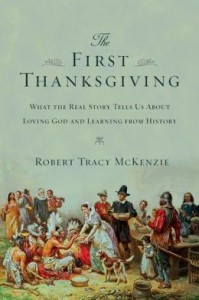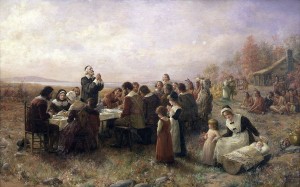A few years ago my parents were on one of those big air-conditioned tour buses that retired Americans sometimes find themselves on. They were out west somewhere and the tour guide was talking about Native Americans. The guide retold the story of the first Thanksgiving and concluded by saying that the Pilgrims gave thanks.to the Indians. He did not mention God. My father, who as Methodist minister is attuned to things theological and historical (and is descended from Puritans, to boot) approached the tour guide afterward and informed him that the Pilgrims gave thanks to God, not the Indians. The guide responded by saying, “I know, but mine is a better story.”
Today one can find not just tour guides but educational curriculum that marginalize religion or neglect to even mention God while teaching us about the Pilgrims. Many Christians are rightfully bothered by this. I know my first instinct is often to turn to historical accounts for ammunition. After all, we want the truth to get out.
But we might be careful what we wish for.
 If you pick up Robert Tracy McKenzie’s new book, The First Thanksgiving: What the Real Story Tells Us About Loving God and Learning from History (and I urge you to do so), you will find that there are a lot of inaccuracies in both traditional and contemporary accounts of the First Thanksgiving. For starters, we don’t know for sure whether or not the Pilgrims and Indians actually ate turkey (though it was quite likely they feasted on geese). Pumpkin pie and yams were definitely not on the menu. They probably served eels, parsnips and turnips, which means that an authentic Thanksgiving dinner would please nobody in my family except my father, who gets excited about eating strange vegetables odd aquatic creatures. Moreover, the Pilgrims didn’t wear big buckles on their shoes and they most likely wore bright clothing.
If you pick up Robert Tracy McKenzie’s new book, The First Thanksgiving: What the Real Story Tells Us About Loving God and Learning from History (and I urge you to do so), you will find that there are a lot of inaccuracies in both traditional and contemporary accounts of the First Thanksgiving. For starters, we don’t know for sure whether or not the Pilgrims and Indians actually ate turkey (though it was quite likely they feasted on geese). Pumpkin pie and yams were definitely not on the menu. They probably served eels, parsnips and turnips, which means that an authentic Thanksgiving dinner would please nobody in my family except my father, who gets excited about eating strange vegetables odd aquatic creatures. Moreover, the Pilgrims didn’t wear big buckles on their shoes and they most likely wore bright clothing.
OK, most of us could live with these adjustments (well, maybe not the eels). But McKenzie pushes the point further, into areas that might bother us more. For instance, the Pilgrims were not a particularly tolerant lot and had enjoyed religious freedom in Holland before they set sail on the Mayflower, which means we need to readjust conceptions that they came to America for religious freedom. Squanto, that friendly Indian whose agricultural advice to the Pilgrims probably warded off starvation during that first winter, was not simply a good-hearted humanitarian who exemplified multi-cultural cooperation, but seemed to be using both the Pilgrims and the local Wampanoag Indians for his own ends. Apparently, neither side trusted him. And that is just the beginning of our historical misperceptions.
It should be pointed out that McKenzie, a history professor at Wheaton College, loves Thanksgiving and is inspired by the Pilgrims. Most of the book, in fact, does not concern itself with correcting historical errors. McKenzie has deeper goals here, deeply Christian goals. As the subtitle of the book states, he wants us to be better at loving God and learning from history.
That means many things. I was helpfully reminded that we ought to turn to history for illumination, not ammunition. McKenzie argues, correctly, that since we are much better at judging others than judging ourselves, authentic education ought to change who we are. He writes about erroneous conceptions of Thanksgiving to help us consider how we have a tendency to distort the past because we want our heroes to be just like us. In fact, if we really dug into the historical record, the Pilgrims would seem strange to us in many ways. That is actually fine, as McKenzie points out, because “if they were just like us, they would have nothing to teach us.” We prioritize rights, for instance, while the Pilgrims prioritized responsibility. There is plenty to ponder there.
We learn how stories of the Pilgrims have been created and put to use by Americans down through history. I did not know, for instance, that the only documentation we have of the first Thanksgiving is a single 115-word paragraph in a letter William Bradford’s assistant sent back to London merchants. Bradford never even mentioned Thanksgiving in any of his writings, though there is a fake document (containing at least six factual errors) circulating on the internet that purports to be a Thanksgiving Proclamation issued by the governor. (False information on the internet? Who knew?) Curious, I googled “Thanksgiving Proclamation William Bradford” and found that the very first link on the list took me right to the imposter proclamation. I was entertained by the fake “Olde English” language of the thing, which was signed by “Ye Governor of Ye Colony.” However, I cringed a little bit to think of all the fifth-grade reports, Christian devotionals and presidential speeches (yep, even our Presidents have fallen for it) that have employed this fake document to inspire us all.

A picture of what the First Thanksgiving really….wait a minute! What are the Sioux Indians from South Dakota doing down at the end of the table? And what did they do with the Wampanoag Indians?
But then, this sort of thing has been going on for a long time, as McKenzie demonstrates. How about the historical novel from 1889 that described how the first Thanksgiving dinner was an occasion just packed with numerous budding romances – the widower Bradford making eyes at Mary Chilton, for instance? The novel imaginatively described, in great detail, the dishes and foods that the Pilgrims supposedly ate at the First Thanksgiving, which the 1897 Ladies Home Journal accepted as historical fact. We’ve been enjoying the historical inaccuracies ever since.
Meanwhile, the “example” of the Pilgrim story has been used to support causes ranging from capitalism, communal living, the melting pot, the war in Vietnam, the regulation of Big Business and, of course, peace in the Middle East. This is just part of the reason why McKenzie argues we should just drop the term “revisionist” when discussing history. History has always been “revisionistic” project and has never been written in pure form, as if it could be special revelation, like Scripture. Furthermore, McKenzie points out that cries of “revisionism” can lead us to mean-spiritedness and self-righteousness, rather than humble self-reflection.
There are a host of other thoughtful points in this book that I can’t even get to. But if we are concerned with historical truth and want to love God better, we should follow McKenzie’s proposal that we approach the past with a stance of “moral reflection” rather than “moral judgment.” Moral reflection requires humility by asking us to question ourselves and engage in respectful conversation with others. Aren’t those some of the qualities that we want Christians to be known for?
This is the kind of history that Christians ought to read. And since The First Thanksgiving does the sort of things that a Christian liberal arts education seeks to do, I’ve decided I’m going to assign it as a text in my American history class.
